Introduction
In the dynamic landscape of data visualization, Power BI themes emerge as vital tools that not only enhance the aesthetic appeal of reports but also ensure consistency and clarity in data presentation. By employing predefined color palettes and formatting options, organizations can create a unified visual identity that resonates with stakeholders and fosters trust. As the demand for actionable insights grows, the ability to customize and apply these themes becomes essential for streamlining report creation and addressing common challenges such as data inconsistencies.
This article delves into the myriad benefits of utilizing Power BI themes, offers practical steps for customization, and highlights best practices that empower teams to transform raw data into compelling narratives. By understanding the strategic application of themes, organizations can elevate their reporting processes, drive engagement, and ultimately make informed decisions that propel growth and innovation.
Understanding Power BI Themes: An Overview
The power BI themes gallery is a crucial resource that offers predefined color schemes and formatting choices, allowing users to establish a cohesive visual identity throughout all documents. By standardizing elements like colors and fonts, these designs greatly improve both readability and the overall professionalism of documents. A well-selected subject not only elevates aesthetics but also effectively directs the viewer’s focus to critical data points, thereby improving insight delivery.
As Jason Himmelstein aptly puts it, ‘We encourage you to leave them on though!’ This highlights the significance of preserving uniform concepts for maximum document effectiveness. The power BI themes gallery offers a variety of available themes—including light, dark, and customizable options—that empower organizations to select the designs that best resonate with their brand and reporting goals.
For example, the case study on ‘Visualization Templates’ demonstrates how adaptable designs simplify the development of documents customized for business situations, ensuring uniformity across visualizations. As organizations progressively utilize real-time information and AI capabilities to identify patterns and correlations, the role of consistent design through the Power BI themes gallery becomes increasingly essential in enhancing user experience and document effectiveness. Moreover, incorporating RPA solutions, like EMMA RPA and Automate, can ease the difficulties of labor-intensive documentation generation and information discrepancies, enabling teams to concentrate on actionable insights that foster growth and innovation.
By unlocking the power of Business Intelligence and RPA, organizations can transform raw information into meaningful insights, enhancing operational efficiency and fostering informed decision-making. To explore how these solutions can benefit your organization, consider booking a free consultation.
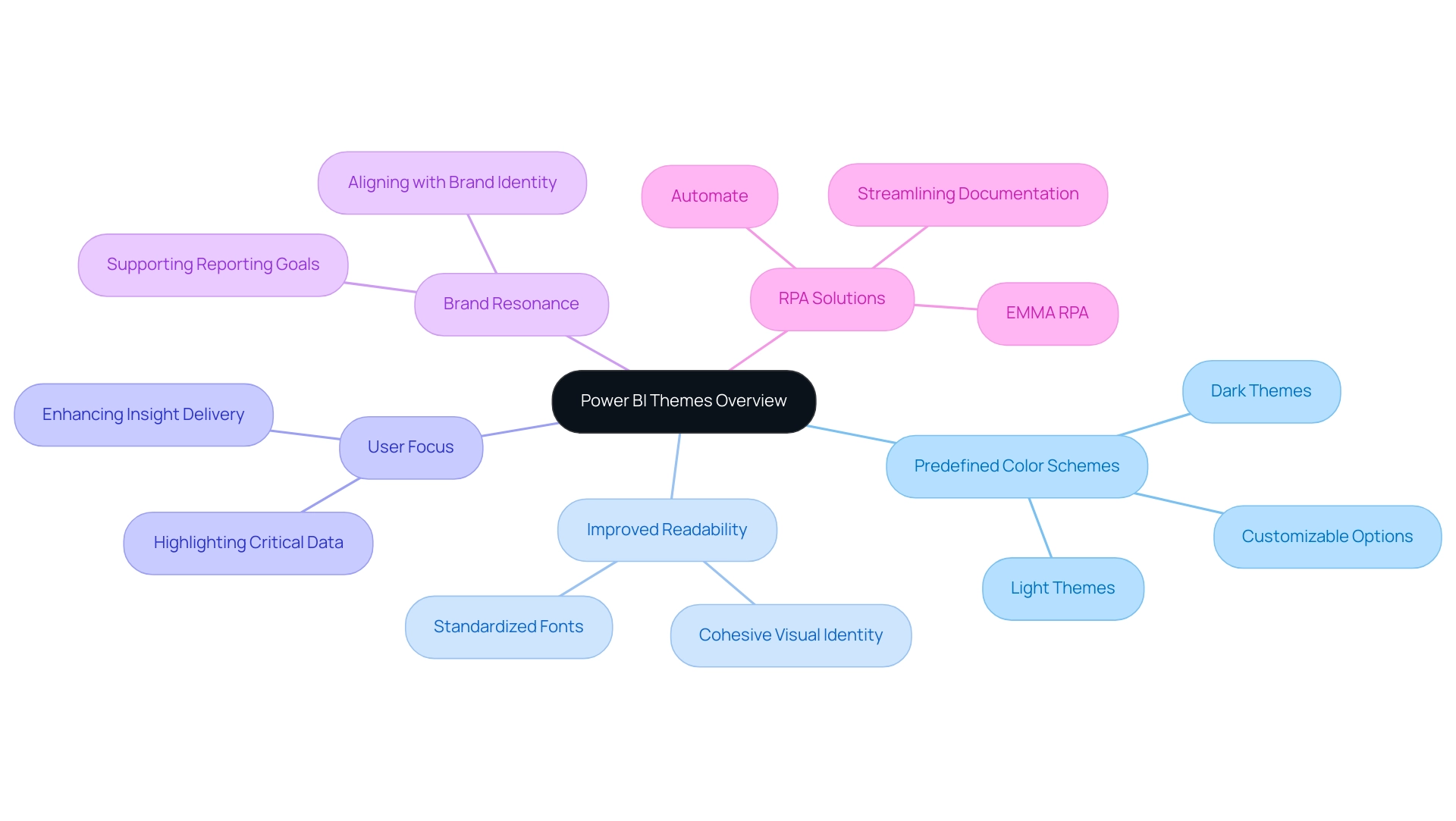
Customizing and Applying Themes in Power BI
Customizing and applying themes in Business Intelligence is a straightforward process that can significantly enhance the visual appeal and coherence of your documents, addressing common challenges such as time-consuming creation and data inconsistencies. Additionally, incorporating Robotic Process Automation (RPA) can further streamline this customization process, allowing for quicker adjustments and greater efficiency in document generation. With over 1,803,674 views on related content, it’s clear that many are interested in this topic.
Follow these steps to get started:
-
To access the Power BI themes gallery, launch Power BI Desktop and navigate to the ‘View’ tab. Click on ‘Themes’ to open the Power BI themes gallery, allowing you to explore your options.
-
Choose a Predefined Design: Explore the available styles to discover one that enhances your document’s aesthetic. Simply click on your selected design to apply it instantly.
-
Create a Custom Theme: For a more personalized approach, click on ‘Customize Current Theme.’ This feature enables you to adjust colors, fonts, and other visual elements to align with your brand or goals, promoting clearer, actionable insights.
-
Export Your Design: After finalizing your customizations, save your design by selecting ‘Export Design.’ This is a significant step, as it enables you to utilize your personalized design across future documents, streamlining your workflow and decreasing the time spent on document creation.
-
Explore the Power BI themes gallery for diverse visual options. Apply Your Design: To utilize your newly created design, return to the Power BI themes gallery and select ‘Import Design.’ Locate your saved theme file and apply it to enhance the visual consistency of your document.
By following these steps, you are not just enhancing aesthetics but also fostering user adoption of your reports, ultimately aligning everyone with your organizational goals. Additionally, it is crucial to implement a strong governance strategy to address data inconsistencies, ensuring that all stakeholders can trust the data presented. As BI operates on a cost-effective SaaS model, it remains accessible for businesses of all sizes.
Participation in webinars and training sessions can further enhance your skills, keeping you informed about trends and best practices in theme customization. As one expert stated,
Your BI adoption strategy should help you identify your goals and get everyone rowing in the same direction.
This approach not only improves quality but also enhances data governance and security, essential elements for businesses, particularly in regulated industries.
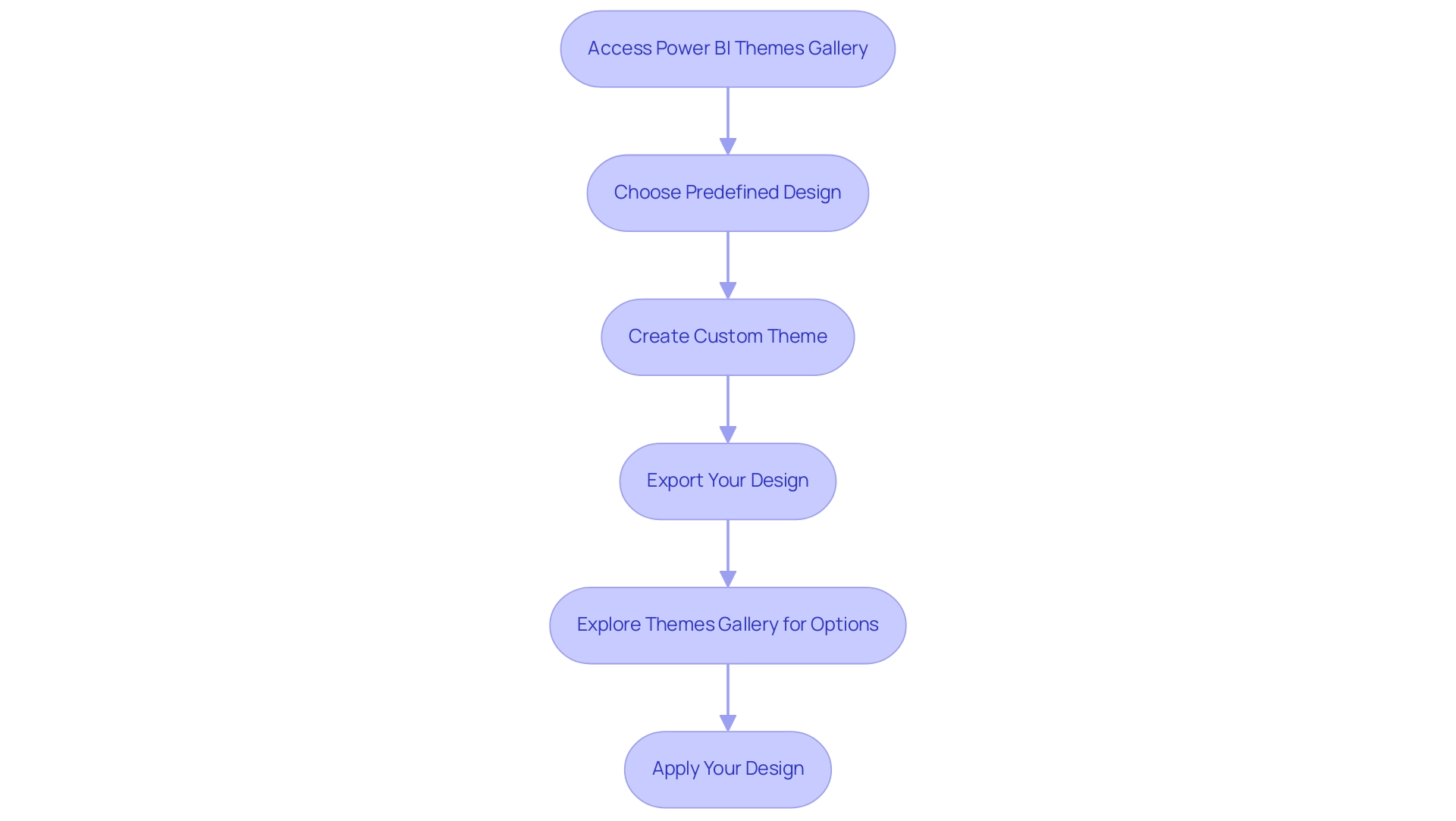
Exploring the Benefits of Using Themes
Implementing custom themes in Power BI significantly enhances the reporting experience through several key benefits:
-
Enhanced Consistency: By utilizing the Power BI themes gallery to apply a uniform theme across all documents, organizations can maintain a cohesive brand identity, which is crucial for building trust and recognition among stakeholders. This consistency directly addresses the prevalent issue of inconsistencies, ensuring that stakeholders see reliable information across various reports. A robust governance strategy can further mitigate these inconsistencies, fostering confidence in the information presented.
-
Improved Readability: Thoughtfully crafted color schemes enhance readability, allowing viewers to concentrate on insights without the distraction of inconsistent formatting. This clarity is vital, as the effectiveness of data visualization often hinges on how easily information can be interpreted.
-
Time Efficiency: Applying a single theme from the Power BI themes gallery to multiple documents streamlines the preparation process, enabling users to focus on analysis rather than formatting. By reducing the time spent on document creation, operations teams can leverage insights from Power BI dashboards more effectively, driving better decision-making across the organization. Incorporating Business Intelligence tools can further improve this process, converting raw information into actionable insights.
-
Heightened Involvement: Visually appealing designs attract attention and make documents more captivating, resulting in greater interaction from stakeholders. As noted by experts, engaging graphics from the Power BI themes gallery play a pivotal role in communicating insights effectively, underscoring the importance of visual appeal in driving engagement.
-
Impact on Stakeholder Engagement: Consistent motifs not only enhance visual attractiveness but also promote a more professional display of information, which can significantly boost stakeholder involvement and confidence in the details presented.
-
Industry Expert Insights: Specialists concur that the Power BI themes gallery can enhance information storytelling, crafting a cohesive visual narrative that connects with viewers, thereby tackling the frequent issue of reports missing clear, actionable guidance.
-
Case Studies on Engagement: The case study titled “Synergy of Text and Graphics” highlights the vital interplay between text and graphics in conveying insights. Engaging in discussions about graphics can enhance understanding and interpretation, demonstrating the practical advantages of a consistent visual approach. Numerous organizations have reported enhanced stakeholder engagement when implementing structured concepts, demonstrating these benefits in action. By understanding and leveraging these advantages, users can elevate their reporting process and ensure that their narratives are compelling and effective.
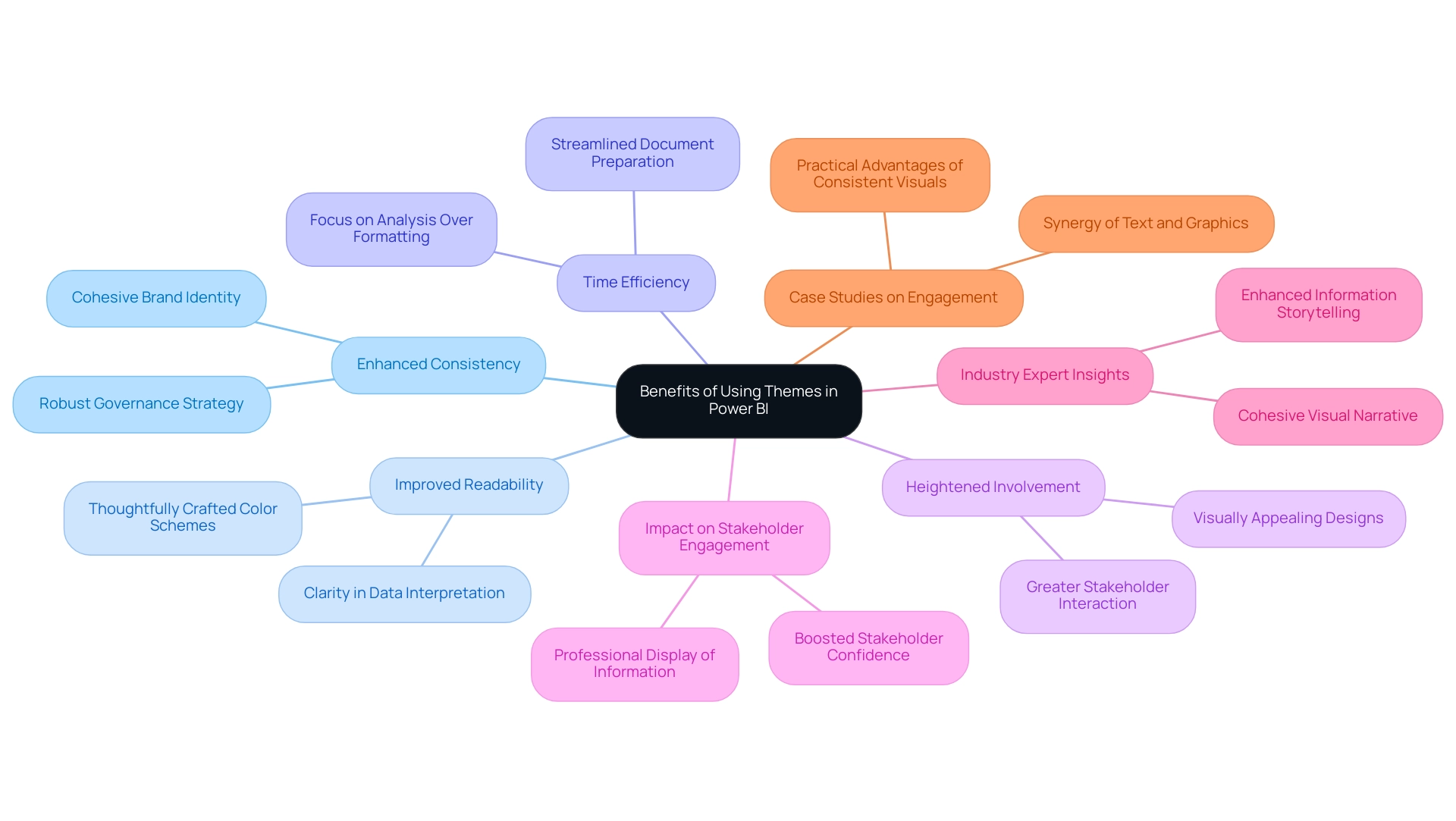
Best Practices for Designing Custom Themes
When utilizing the Power BI themes gallery to design custom themes, it’s crucial to follow several best practices that improve both aesthetics and functionality, particularly given the typical challenges of time-consuming project creation, inconsistencies, and absence of actionable guidance. First, limit your color palette to a maximum of five hues to prevent overwhelming viewers and ensure clarity in your visual communications. Select colors that not only complement each other but also align with your brand identity.
According to Tufte’s Chapter 5 from ‘Envisioning Information’, distinctive hues in diverging palettes are crucial for differentiating between positive and negative values relative to the center, which can effectively convey information variance and help mitigate confusion from inconsistent information across documents. Second, ensure that text and background colors provide sufficient contrast to enhance readability—this is crucial for effective information interpretation and actionable guidance. To offer practical insights, think about adding a summary section in your documents that converts intricate information into clear suggestions or next steps based on the visualized information.
Consistency is essential; apply uniform font styles and sizes across all visuals to foster a cohesive appearance, thereby reducing the time spent on adjustments. Furthermore, consider accessibility in your design choices by selecting color combinations that are accommodating to color-blind users, ensuring that your data is interpretable by everyone. Ultimately, always test your design by previewing it within various reports to confirm its effectiveness across different contexts.
Applying these best practices will enable you to design visually attractive BI styles that efficiently serve their intended purpose, utilizing the Power BI themes gallery. As Hussain Ismail Lokhandwala notes,
Sequential color schemes are beneficial for visualizations representing ordered data, utilizing variations in a single hue to indicate a natural progression from low to high values.
This insight underscores the importance of thoughtful color selection in facilitating viewer comprehension and supporting stakeholders in making data-driven decisions.
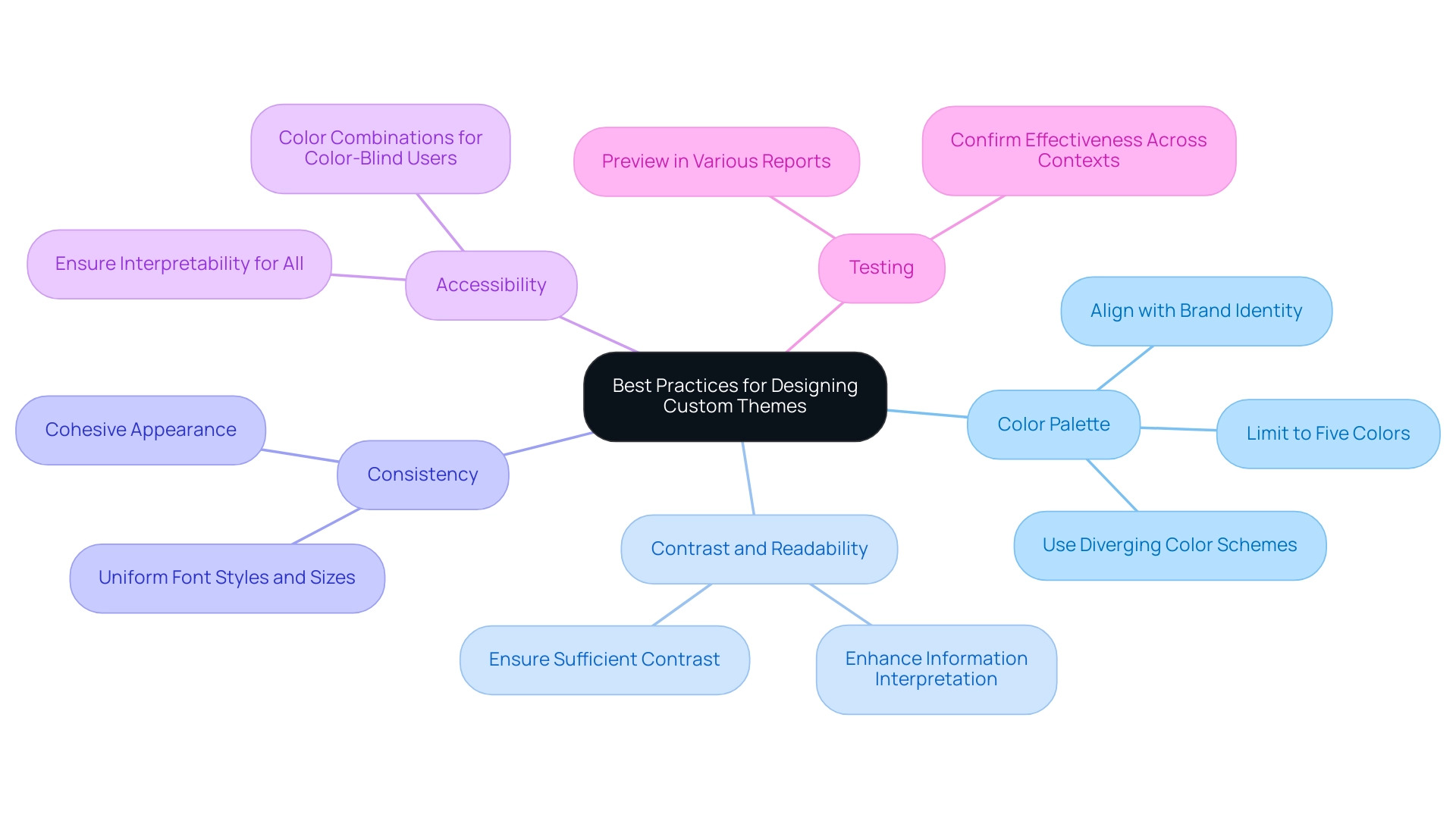
Sharing and Reusing Themes in Power BI
Utilizing the Power BI themes gallery for sharing and reusing styles is an effective way to enhance collaboration and ensure consistency in your reports. Here’s how to do it:
- Export Your Design: Once you’ve customized your design to fit your needs, click on ‘Export Design’ in the Designs Gallery to save the JSON file.
- Distribute the Theme File: Share the saved JSON file with your colleagues through email, shared drives, or collaboration tools, ensuring everyone has access to the latest version.
- Import the Design: Colleagues can easily import the design by navigating to the Power BI themes gallery, selecting ‘Import Design,’ and then choosing the shared file.
- Document Your Concepts: Consider creating a brief guide detailing how to use the concept and its intended purpose, which will help others understand its application effectively.
By sharing themes, users not only promote visual consistency across documents but also foster collaborative insights that enhance data presentation. Furthermore, publishing documents to the web allows anyone on the Internet to view Power BI visuals without needing a license, which can significantly broaden access and collaboration.
To maximize the potential of your Power BI capabilities, consider participating in our 3-Day Power BI Sprint, where we create fully functional, professionally designed visuals tailored to your needs, ensuring a quick start and a polished finish. This initiative frees you from the tedious aspects of document creation, enabling you to focus on leveraging insights for impactful decision-making. Furthermore, the document produced during the sprint can act as a valuable template for future projects, ensuring a professional design from the start.
Granting users build access to create new documents and dashboards based on shared content can further enhance teamwork and efficiency. A case study showcasing the benefits of utilizing OneDrive for Power BI files illustrates this point: it demonstrates how loading PBIX files from OneDrive enables automatic hourly refreshes and built-in version control, allowing users to manage their files effectively and ensure that team members have access to the latest versions of documents. Recent statistics indicate that effective theme sharing practices can significantly boost user engagement levels with shared reports.
As Mike Carlo, an expert in Sharing & Administration, puts it,
Make sure you share this blog with another person if you found it valuable.
This highlights the importance of spreading knowledge and resources within teams for improved operational efficiency.
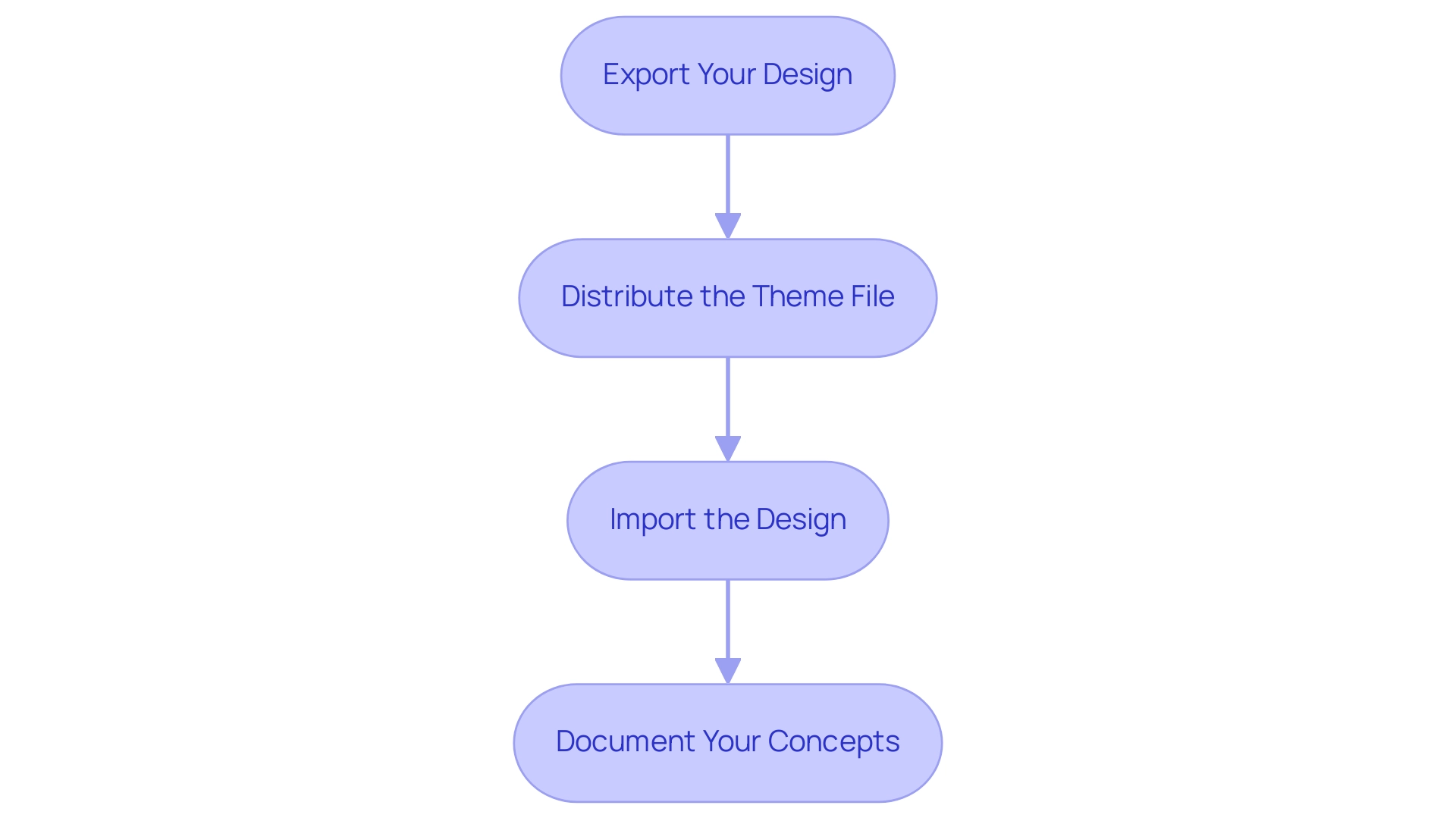
Conclusion
Implementing Power BI themes is a strategic move that can transform the way organizations present data. By standardizing color palettes and formatting options, teams can create a unified visual identity that not only enhances the aesthetic appeal of reports but also improves clarity and consistency. This approach addresses common challenges such as data inconsistencies and time-consuming report creation, allowing teams to focus on extracting actionable insights that drive growth.
Customization is key, as it enables organizations to tailor themes to their specific branding and reporting objectives. Following practical steps for theme customization and adhering to best practices can significantly improve readability and engagement. By limiting color palettes, ensuring adequate contrast, and maintaining consistency in fonts, reports become more accessible and easier to interpret, ultimately leading to better decision-making.
Moreover, sharing and reusing themes fosters collaboration and enhances the overall reporting experience. This practice not only ensures consistency across reports but also encourages a culture of knowledge sharing and teamwork. By leveraging these strategies, organizations can elevate their data visualization efforts, transforming raw data into compelling narratives that resonate with stakeholders and support informed decision-making. Embracing the power of Power BI themes is not just about aesthetics; it’s about creating a robust framework for effective communication and operational efficiency that propels organizations towards success.

